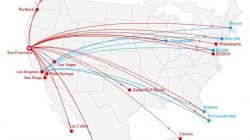Economic slowdown in Brasil plunges DFW’s nonstop flight to “Cidade Maravilhosa”
American Airlines’ decision to end its Dallas/Fort Worth to Rio de Janeiro flight in February 2015 underscores the difficult competitive environment in Latin America due to the macroeconomic slowdown in Brasil and continued exposure to the Venezuelan cash crisis. This is American’s second Latin American route which will be curtailed from its largest hub at Dallas/Ft. Worth, as it has ceased operating flights between DFW airport and Caracas, Venezuela since July 2014.
Although Dallas/Ft. Worth airport is a secondary gateway market to Latin America network, eclipsed by American’s predominant Miami hub, the loss of these two routes from DFW are notable given American’s recent spool-up in transpacific services from DFW airport to Seoul, Hong Kong, Shanghai and potentially Beijing. One of the major selling points for launching new Asian rotues from Dallas was its fairly robust Latin American network to cities such as Santiago, Sao Paulo, Buenos Aires, Bogota and Lima, the latter two of which have been added within the past 18 months.
Related:
>American applies for Dallas/Ft. Worth to Beijing route, Asia push continues
American Airlines announces DFW-Hong Kong, Shanghai
Despite American’s buildup to Asia from DFW airport, transit traffic to Latin America cannot support underperforming trunk routes
Truth be told, even with the immense international traffic growth at DFW, the routes to Rio de Janeiro and Caracas could not be supported merely by transit traffic to and from Asia. Caracas, understandably, is a casualty of frozen funds in Venezuela that have been stuck in repatriation limbo for several years, and is not necessarily a problem specific to DFW. American has also suspended services between New York JFK and Caracas and greatly reduced frequencies operating between Miami and Caracas and Maracaibo.
American and LAN cut schedules to Venezuela as cash crisis worsens
Rio de Janeiro, conversely, is a market American was keen to connect to its largest hub in its pre-Chapter 11 bankruptcy days, having received 3-weekly frequency allocations to commence service in December 2010. However, in the years that followed, American maintained a relatively flat level of capacity on the route, up-gauging frequencies only during peak season between late December and February and maintaining a 767 on the route year-round. In the years that followed, as American secured additional rights to add more frequencies to various Brasilian cities, DFW-Rio de Janeiro was always overlooked in favor of launching new routes to secondary points from Miami, such as Porto Alegre and Curitiba, and adding a daily nonstop from Los Angeles to Sao Paulo.
American Airlines applies for additional service to Brasil
It is therefore conceivable that American’s DFW-Rio de Janeiro route was a marginal performer on a year-round basis, and given economic uncertainty in the Brasilian macro-economic climate, the decision to pull the plug on the route. American had also tried and failed to secure rights to operate a nonstop from its Chicago O’Hare hub to Sao Paulo, but it appears that in the near-term, those plans have been shelved. This is likely a sensible decision given that the open skies agreement between Brasil and the US will involve a sizable push in capacity at a time when the economy has cooled, which may had pressure on yields and RASM performance.
American’s focus to shift to Miami and New York due to competitive environment
American’s decision to end DFW-Rio de Janeiro likely also involved a need to refocus its attention on the Miami – Brasil and New York – Brasil markets. With the US and Brasil moving into an Open Skies agreement in 2015, a new entrant will arrive in the form of Azul Linhas Aereas, founded by JetBlue founder and former CEO David Neeleman. The Brasilian low-cost carrier has received several widebody aircraft, the first of its kind, to operate nonstop services to Fort Lauderdale, Orlando and New York JFK from its hub at Sao Paulo Viracopos airport, located in Campinas, Brasil (northwest of Sao Paulo), all by mid-2015. Azul will be able to capitalize on its strong point-of-sale from the Brasilian side, as well as the ability to connect onward itineraries from secondary and teritiary cities within Brasil. In response to Azul, American is launching a 3-weekly service from New York JFK to Viracopos and a daily service from Miami to Viracopos.
American has also chosen to end two pre-merger US Airways routes to Brasil from its Charlotte hub. American cancelled service between Charlotte and Sao Paulo on October 1, 2014, a route that US Airways had coveted for many years, but was unable to launch until as late as May 2013 due to a series of political setbacks. American also terminated year-round service between Charlotte and Rio de Janeiro in September 2014, a more legacy route that has been in operation since mid-December 2009. The route will resume on a temporary basis between early December 2014 and late January 2015, but no indication has been given if it will continue to operate on a seasonal basis in the future.
DFW-GIG, and potentially Charlotte – GIG, may return in the future, but only seasonally
There is a slight probability that American may retain seasonal links to Rio de Janeiro from Dallas/Ft. Worth and Charlotte in the future, but likely during a few weeks during peak summer periods, holidays and Carnaval. American is favored by the advent of US-Brasil open skies agreement in 2015, along with the relaxed capacity and airport constraints at Rio de Janeiro Galeão International airport that doesn’t require new nor returning entrants to apply for landing slot times. Furthermore, the demand for travel to Brasil peaks in the Northern IATA winter, which is certainly slower for widebody aircraft deployed on transatlantic routes to Europe. As such, American may have extra slack in its fleet to absorb additional demand from its non-New York/Miami hubs to Rio.
Additionally, the plethora of one-stop connections via Miami, Sao Paulo, Lima and Bogota (on LATAM Airlines) provide a wide range of options for DFW travelers headed to Rio de Janeiro. Unfortunately, those hailing from other parts of the country, such as Denver, Salt Lake City, etc. will have to double connect, or route via Houston on United. The Houston – Rio de Janeiro flight, which has been in operation since 2009, is largely profitable due to oil and gas connections, and has been flown as a daily 777 for several years.
As painful as it is to see American restructure several of it and legacy US Airways’ routes to a historically profitable geographic region in the world, the carrier has smartly adapted to the economic cycles and, as is true with all major mergers, contraction is bound to happen in places that are not always pleasant.




